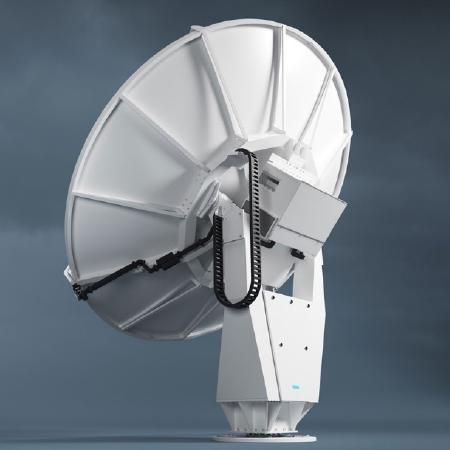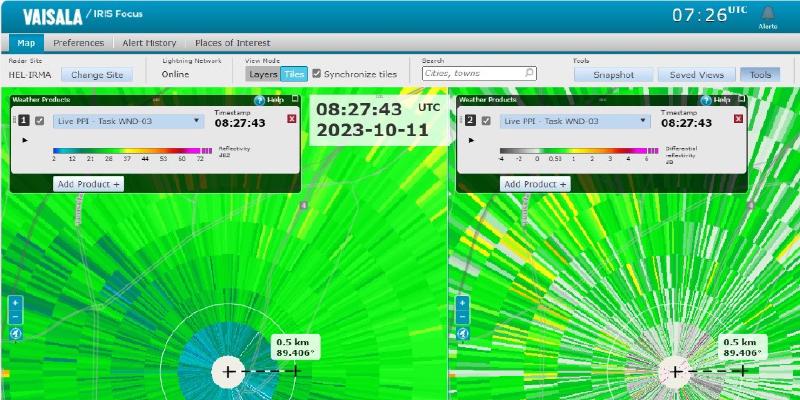Q&A: frequently asked questions about Vaisala SSPA weather radars
Solid-state power amplifier (SSPA) is the future of weather radar design, and Vaisala SSPA radars are at the forefront of this evolution. Learn more about our SSPA radars with these frequently asked questions.
Q: How does hybrid pulsing work in Vaisala SSPA radars?
A: Vaisala provides comprehensive information about this subject in our new technical paper, “Hybrid pulsing in Vaisala solid-state weather radars”. Download a free copy of the technical paper: Hybrid pulsing in Vaisala solid-state weather radars.
Q: Why is the transmitter located at the back of the antenna?
A: Traditionally, radar transmitters have been enclosed in an equipment cabinet, located beneath or near the radar tower with the antenna. With new SSPA transmitter technology, it is possible to locate the transmitter at the back of the antenna. This is mainly due to their smaller size and robust design.
Placing the transmitter and receiver close to the antenna provides multiple benefits in system performance, reliability and life-cycle costs.
From a measurement performance viewpoint, placing the transmitter and receiver at the back of the antenna offers the best design for optimized sensitivity. All excess attenuation can be removed by minimizing the waveguide length in the system and eliminating the waveguide rotary joints, which further optimizes system performance.
From a reliability viewpoint, this design does not require waveguide rotary joints — expensive components that are subject to wear and tear and can cause downtime for maintenance or replacement.
From a life-cycle cost viewpoint, this design offers the most cost-effective radar design. With minimal attenuation in the system, lower transmitter power is needed to reach the desired sensitivity. On average, waveguides and waveguide components needed with a traditional design with the transmitter in a separate cabinet causes an attenuation of 2-3 dB (two-way attenuation in waveguides of a 20 m tower), roughly cutting the transmitted power in half. With the transceiver located at the back of the antenna, you can reach the same sensitivity with lower investment cost.
Also, there are fewer components in the system that are subject to wear and tear and cumulative costs, such as waveguide rotary joints.

Q: What is the blind range for Vaisala SSPA weather radars?
A: In pulsed radar systems, the receiver is typically blocked during the transmit pulse. This protects the sensitive front-end of the receiver, as the isolation between the transmission and reception directions is limited. This blind range around the radar is fairly long when using long compressed pulses in a SSPA radar.
To cover the blind range caused by the long pulse, the radar transmits a short conventional pulse right after the long compressed pulse, at a slightly different frequency. These two pulses can be separated in reception due to the frequency offset. This method is called hybrid pulsing. In hybrid pulsing, the blind range around the radar reduces back to the blind range caused by the conventional short CW pulse.
In addition to the transmit pulse itself, there is a short recovery time associated with the receiver front-end and its protection (the receiver protector component is often called the limiter). This recovery time is only a few microseconds, about 3 µs.
For example: Transmitting a 1 µs short pulse followed by 3 µs receiver recovery time leads to a 4 µs or 600 meters blind range.
The specification in Vaisala SSPA weather radars is that the blind range with 1 µs pulse is less than 1 km. Figure 1 shows how the blind range appears in the radar data. We are starting to see consistent data from about 500 m onwards. This is consistent with the previously described transmission and recovery times.

Figure 1. WRS300 data example of reflectivity (dBZ) and differential reflectivity data moments taken from Vaisala IRIS Focus during moderate rain. The measurement was done using 44 µs + 1 µs hybrid pulse.
Q: What is the close-range sensitivity with the short pulse?
A: Vaisala provides comprehensive information about this subject in our new technical paper, “Hybrid pulsing in Vaisala solid-state weather radars”. Download a free copy of the technical paper: Hybrid pulsing in Vaisala solid-state weather radars.
Q: What are the maintenance requirements for Vaisala SSPA radars with the receiver and transmitter at the back of the antenna?
A: Our SSPA radars have been designed with ease of maintenance in mind. Mechanically, both radars are designed so that components are easily accessible through access hatches. Like our legacy radars, our new SSPA radars do not require oil or greasing, due to the maintenance free, long-lifetime belt drives used in both azimuth and elevation. The pedestal slipring is also maintenance-free.
The yearly preventive maintenance procedure mainly consists of visual checks and as a recommendation, the yearly calibration. More information on the calibration procedure can be found in the technical paper: Hybrid pulsing in Vaisala solid-state weather radars
Q: What’s the measurement range of Vaisala SSPA radars?
A: A typical maximum usable measurement range for a C-band (or S-band) weather radar is in the order of 250-300 km. The range is not limited by the measurement sensitivity of the radar system itself, but by the curvature of the earth. If we think, for example, a range of 500 km from the radar and a typical lowest measurement elevation of 0.5 degrees, the center of the antenna beam, and thus the measurement volume, is more than 20 km above the earth surface. There is rarely precipitation at this height. However, if there is a tall thunderstorm 500 km away from the radar rising above 20 km, our C-band Weather Radar WRS300 can easily detect it. (The minimum detectable reflectivity at 500 km is in the order of 0 dBZ, depending on the radar configuration.)
For X-band radars, the maximum operational range is typically kept shorter, as the attenuation in heavy rainfall may start limiting the maximum range, and typical applications (gap fillers, airports, local weather observations) do not require extending the measurement range further than 100-150 km. However, in theory, there is nothing limiting an X-band radar (like Vaisala WRS400) from detecting precipitation hundreds of kilometers from the radar, provided that the measurement task is configured to collect data this far and there is not very heavy precipitation close to the radar which would limit the maximum range due to signal extinction.
Q: How does clutter filtering work in Vaisala SSPA radars?
A: The most common clutter filtering method (for fixed clutter targets) in modern weather radars is based on Doppler measurement. The Doppler measurement in the SSPA radars works the same way as conventional pulsed CW radars, and is based on the Fourier analysis of several consecutive pulses.
The performance of the Doppler measurement, and thus the clutter filtering, is limited by the system phase noise. Modern SSPA radars are fully coherent systems with excellent phase noise characteristics.
The clutter cancellation ratio in Vaisala SSPA weather radars is typically better than 50 dB. The performance of the clutter cancellation of the Vaisala SSPA radars has been verified by comparing filtered and un-filtered reflectivity data from identified ground clutter targets. Both WRS400 and WRS300 systems are capable of better than 50 dB clutter cancelation ratio without sacrificing data from overlapping weather. Figure 2 shows an example measured by WRS400 system located in Vantaa, Southern Finland.

Figure 2. Filtered and unfiltered reflectivity measured from a heating plant near WRS400.
Q: How do the lifetime costs of Vaisala SSPA radars compare to traditional magnetron radars?
A: Due to the cost of the SSPA amplifiers, the initial investment cost of C-band SSPA radars is still higher than magnetron systems. However, throughout its lifetime, the SSPA radar is expected to beat the traditional magnetron systems. When comparing lifetime costs of the WRS300 C-band SSPA system to traditional magnetron systems, or with competing SSPA systems with traditional cabinet design, the savings can be divided into delivery project costs and maintenance costs.
Due to the smart design of the WRS300 system, the delivery project of the radar is more streamlined and cost efficient. As the waveguides in the system only go from the front of the antenna to the transceiver behind the antenna, there is no site-specific waveguide design and installation required. The radar is delivered from the factory with all needed waveguide components.
From a maintenance cost viewpoint, the SSPA transmitter has no consumable components that would need to be periodically changed. The solid-state power amplifiers are long-lifetime components that do not degrade the same way as magnetron tubes do. In the lifetime of a magnetron radar, the tube needs to be typically replaced 2-3 times due to degradation.
Due to the compact design of the WRS300, there are no waveguide rotary joints. These rotary joints are expensive and subject to wear and tear, and need to be maintained or even replaced during the radar’s lifetime. It should also be mentioned, that due to the smart design of the WRS300 radar, the attenuation in the waveguides and waveguide components have been minimized. This means that the WRS300 can reach the same system sensitivity then competing systems with traditional system layout with significantly lower peak power. And in weather radar measurements, the system sensitivity is more important than transmitter peak power.
The lower peak power need of the WRS300 also shows in lower lifetime costs due to limiter design. Higher peak power systems are forced to use discharge tube limiters in the receive channel. Due to the discharge tube design, the performance of these components degrades over time, leading to a grown blind zone around the radar. In WRS300, due to the lower peak power need, solid state limiters can be used which do not degrade over time like the discharge tube limiters.
Q: What calibration procedure is needed for the Vaisala SSPA weather radar?
A: Vaisala provides comprehensive information about this subject in our new technical paper, “Hybrid pulsing in Vaisala solid-state weather radars”. Download a free copy of the technical paper: Hybrid pulsing in Vaisala solid-state weather radars.

